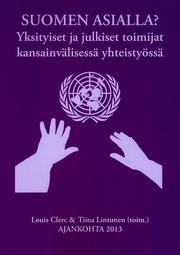There are two projects I have been working on, and that reached their conclusion in the end of the year. Both were in Finnish, and both were conducted in the margins of my larger research projects – until they eventually came to occupy most of my time, as always. But there is always next year…
The first was a contribution to a book on presidential elections and political activism. The contributions related mostly to Finland, and mine was meant as some kind of comparative case. I dealt with the French presidential elections in 2012, and especially with the primaries organized by the Socialist Party. That was interesting to do, because it gave me an excuse to read plenty of things on the ideological divisions existing inside the Socialist party, but also on the way the party works as a political organization. Nothing ground-breaking here, but a good occasion to reflect on these things in Finnish. I concluded with some scenarios Jacques Kergoat presented for the Party in 1997: the transformation of the Party into some sort of democratic party à la francaise, or its “social-democratization”. The current situation seems to mix both: the party has become an ideologically more diffuse, socially wider political force, that tends to represent more than just the social groups it used to represent; at the same time, it has become more “social-democrat” in its ideology and in its practices.
For those of you able to read it, the book here. And here a panel organized by the editor at this year’s Helsinki Book Fair, on presidents and presidential regimes. I sat there as the Francais de service. I was lucky enough to be on this panel with Russian-American journalist and writer Masha Gessen, whose book on Vladimir Putin has just been translated in Finnish. Masha got most of the attention – which was wonderful, because she had very interesting things to say. Check her work.
A word on the editor: Kalevi Sorsa Säätiö is named after the long-term Finnish Prime Minister Kalevi Sorsa, a social-democrat. The Foundation has close links with the Finnish SD Party, and one could compare it with the French Terra Nova, for example. We were, however, left completely free to write whatever we wanted.
The second project was a bit closer to home. I was asked for a contribution to a book on media studies to look into the way students of foreign policy history could use media sources. I tried to emphasize the importance of contextualization, and three ways researchers could use these sources: as direct sources in the reconstruction of sequences of events or phenomena; as a vintage point in the intricacies of decision-making, and especially on the information available to decision-makers; and finally as a window on the wider cultural context in which foreign policy decisions are taken. Most of the cases came from my PhD.
The scope of the contribution was limited to studying the history of basic foreign policy decision-making. That was a classical premise, which I stuck to in order not to get my point lost to the reader – good enough that it wasn’t lost to me… The point being that, well-used, media sources and other “unorthodox” sources (literature, etc) could and should be used to frame foreign policy decisions, to render the larger context in which these decisions are taken and that contributes to explaining these decisions.
The book is part of a series edited by the Turku Historical Society (Turun Historiallinen Yhdistys), Historia Mirabilis.



